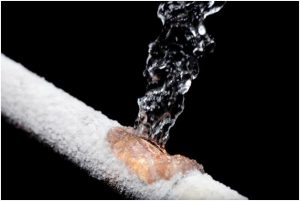How to prevent freezing of pipes?
Frozen pipes are all too common during the cold months. When the water freezes, it expands and when it expands inside the hydraulic pipes it puts the entire system at risk. The increase in pressure inside the pipes makes them subject to cracking. And you don’t want to deal with a pipe that burst in the middle of winter.
How much damage can a frozen pipe cause? Let’s put it this way: a seemingly small 1/8 inch crack can release 250 litres of water per day. Flooding from a burst pipe can cause mould and costly structural damage. Homeowners should take all necessary precautions to prevent this disaster from happening.
But how to avoid frozen pipes? Read on to find out.
Temporary tricks to avoid frozen pipes

Even if you can’t control the weather, you can protect your pipes from freezing. Some preventative measures will keep the pipes above freezing and intact even as temperatures plummet.
Make the taps drip: in case the forecast calls for freezing temperatures, open the taps of hot and cold water in your home a little. Accordingly a slow and steady drip will keep the pipes warm and reduce the pressure.
Protect external faucets: Make sure to close and empty all external faucets. Disconnect all the water pipes. Use the tap covers to keep the taps insulated and protected from falling ice.
Open cabinet doors: exposed pipes under the bathroom and kitchen sinks are subject to freezing. Therefore, open the cabinet doors to allow hot air to reach the pipes.
Keep the furnace to a minimum – get out of town? Make sure you program your oven to work even when you are not at home. So if the house gets too cold, you could go back to a burst pipe.
Open the air vents: avoiding cold areas is essential. Keep the air vents open so that hot air blows into every room.
It is best to implement these low-cost interim solutions as soon as temperatures begin to drop. Waiting too long can cause disaster. Have you noticed the ice crystals on your inner tubes? Use a low-heat hair dryer to slowly melt the ice. If you lose power in sub-zero weather conditions, immediately insulate and cover any pipes that could burst.
Permanent ways to protect your pipes
While temporary solutions are useful, long-term solutions, although more expensive, provide even more peace of mind and will protect pipes from freezing for many years to come.
Try these permanent methods to avoid freezing pipes

Insulate your crawl space: take a look at your crawl space. Notice all the exposed pipes and ducts? The insulation of this often neglected area will protect your pipes.
Replace Standard External Faucets: Conventional faucets are vulnerable to freezing. The installation of frost-proof taps will add a layer of protection to help prevent pipe bursting in cold climates.
Redirect Pipes: Do your pipes travel through the coldest parts of your home? In this case, hire a plumber to divert the lines to a more protected area.
Insulate the walls: how well insulated is your home? Pipes located in the outer walls are prone to freezing because they are closer to the cold. Consider the idea of adding more insulation to the inside of the walls.
Repair cracks in the external wall: holes and cracks are the first access routes for cold air. Before freezing temperatures arrive, fill the cracks in the exterior walls with an approved putty or sealant.
Prepare your home for the next freeze.
It is impossible to prevent frost, but you can protect your pipes. Will your pipes survive the next freeze? Emergency Plumber Wolverhampton offers pipe freeze prevention services.
Call 01902933956
